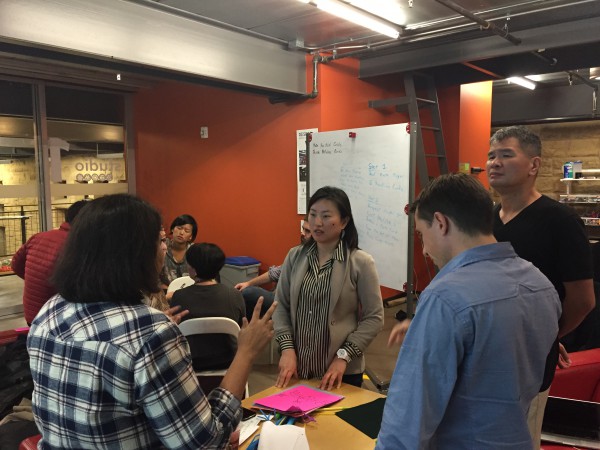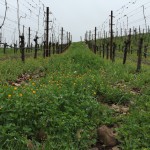Insights after the dust settles

Students work with Jen Cotton, a designer at Twitter, during their final design review for Redesigning the News Ecosystem. (Emi Kolawole)
It’s over. In fact, it has been over for a while. I just needed some time to recover.
The class, in all, was a wonderful prototype — an attempt to have a group of people from multiple disciplines consider the entirety of the news ecosystem, ascertain a challenge worth tackling and wrestle with deeply-held assumptions.
I had one, simple gauge for success: one person walked away recognizing the power of empathy in breaking through this incredibly sticky and broad challenge. While my lecture on empathy fell somewhat flat, I heard from a couple of students that they had a new understanding of empathy in relation to the traditional journalistic interview — a huge achievement, at least from my vantage point.

Jae Rhim Lee (center), a d.school fellow, artist and former TED fellow, tests prototypes with students. (Emi Kolawole)
The larger goal, however, was to have students arrive at new insights when it comes to information, media and, yes, the news. I say the “news” last because, the news is merely a subset of information and is expressed through media. It’s the media part I am particularly interested in. In all honesty, I don’t quite have my head around the size of the challenges — yes, plural — that exist for me and the d.school’s media design team in that space.

Mike Davidson, Vice President of Design at Twitter (center) works with students as they test their prototypes. (Emi Kolawole)
The journey of a million miles starts with a single step, and this class has let me sprint quite a few steps in the form of deep insights and fascinating prototypes. Now, I am not going to list all of the prototypes we tackled in class. Instead, I am going to go through a few. This isn’t me showing favorites — they were all my favorites. But these prototypes helped me arrive at insights around the design thinking process, instruction of that process, creative confidence as well as the news industry and media as a whole.
Before we get started, please keep in mind, I am recounting what I remember based on very few notes, given I was busy running class. An excuse? Perhaps. But I really did want to focus on my students’ experience in the moment. So, a price must be paid. That said, I think there’s a value in what and how I remember the experience. Disagree? Let me know in the comments.
Pivoting with constraints: “Pink It”
I introduced a series of constraints in the second class, which called on students to pivot their designs considerably. They were asked to iterate on their ideas with the constraint that they had to involve the color pink, for example, or something from nature. The constraints forced students to consider their prototypes in an entirely new light. This pivoted at least two of the prototypes considerably.
Now, why did I do this? One of the things I am most fascinated by is getting people to design outside of the world of apps.

Students work with Jay Hamilton, the Director of Stanford’s Journalism Program, (right) testing “Pink It”, one of the prototypes created during class. (Emi Kolawole)
The app, particularly in media, is like the Swiss Army knife of solutions. It unlocks any door, except when it doesn’t — which is more often than I think people are willing to consider. The rush to an app can often obscure the needs of the people for whom a team is designing. That being said, one project pivoted within the digital space, but once it did, the team became much more excited about their work.
They iterated so rapidly I could barely keep track of their work. The team created an application that, when you highlight a word, it would pull up relevant news stories to that work, building a more strongly curated list the more the user engaged. It was amazing. The highlight color was pink, going back to one of the constraints.
Another team ended up designing a card game to help bolster people’s understanding of the news. “Cards Against Journalism” went from being a digital heads-up style game to a physical card game. I really hope the team moves forward and makes it (albeit with a different name, perhaps), because I sincerely want to play this game with friends!

Students test their prototype, a card game, with d.school fellow, designer and Stanford Sloan Fellow alum Jason Mayden (center). (Emi Kolawole)
Now, what does this mean for my future work? It means I will be introducing random constraints much more often and rapidly. It seems to really help people poke holes in the cage of traditional thinking when it comes to innovation in media.
Serendipity, context & curation: Is the phone call the new newsletter?
Serendipity, context and curation were popular themes in this class. During the empathy interviewing and observation portion of the class, students came back with a number of comments from interviewees around these concepts. They said they found that people expressed a need for better curation, more context and a serendipitous experience.
Much of these findings spoke somewhat to the “filter bubble” phenomenon. Interviewees were recognizing that they were getting either the same old information over and over again or were being confronted often with information that they didn’t want or had no context for. The lack of context is a popular problem and is attempting to be addressed by a number of news sites, including major media organizations. The volume of news and information available and the demands on people’s time to cut through that as well as other data (e-mails, voicemails, etc.) infiltrating their lives make gaining context difficult.

Jen Cotton (center) and Dave Wright (far right) test a prototype during the final class of Redesigning the News Ecosystem. (Emi Kolawole)
Three teams employed phone calls in their prototypes. One team developed a concierge news service, which would employ flesh-and-blood journalists to help people navigate the news by investigating their news habits through in-depth question-and-answer sessions. Another prototype employed artificial intelligence to bring a customized news experience to people via phone. A third prototype made a phone call with pre-recorded news updates a user had indicated they would find relevant. It made me wonder whether the phone could be the next “throwback” technology to re-shape the news ecosystem, much as the newsletter and the podcast appear to be resurgent.
Say it like it is.
There’s power in being frank. One of the teams developed a prototype called “Give a Shit News”. The prototype, an app, was made to be highly interactive, adding opportunities to news stories for readers to get involved — or show that they, well, give a shit. The app was among the most popular in the class, for at least one obvious reason. There’s a power to curse words, sure. But there’s also a power to just saying it like it is. I was reminded of sites such as Upworthy and even my own prediction that journalism would need to incorporate more from the world of activism.
Now, I am realizing, there needs to be a greater frankness as well. When a new product comes on line, I’ll try and be more open about asking (hopefully with poise and grace), “So, tell me why should I give a shit? Who’s need are you meeting and what did you learn in the process of getting to your solution?”

Students test their prototype with Amanda Noonan, the Director of Research and Learning for Internews (top right), during the final class of Redesigning the News Ecosystem. (Emi Kolawole)
…and then it was over.
The class was a typhoon of activity, and much of my brain was dedicated to planning and embracing the unexpected. Thanks to Dave Wright of Twitter, Tyson Evans of The New York Times and Laura McClellan Pickel, our extraordinary experience assistant, for braving the experience with me, and making for the best teaching team for which anyone could ask. Thanks to our special guests who attended and judged our prototypes:
- Amanda Noonan, Director of Research and Learning at Internews
- Jae Rhim Lee, d.school Fellow and Artist
- Jason Mayden, d.school Fellow, Designer and Stanford Sloan Fellow alum
- Jay Hamilton, Director of the Stanford Journalism Program
- Jen Cotton, Designer at Twitter
- Mike Davidson, Vice President of Design at Twitter
Thanks especially to our students who took this class — this prototype, really — in stride, and met us where we were … then, flew past our expectations.

Redesigning the News Ecosystem: The final stretch
by Emi Kolawole|February 12, 2015


